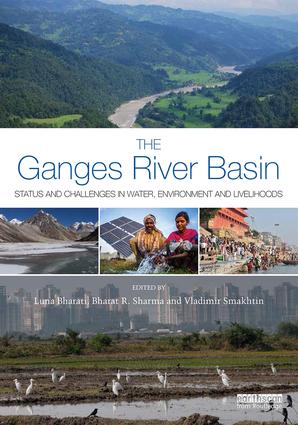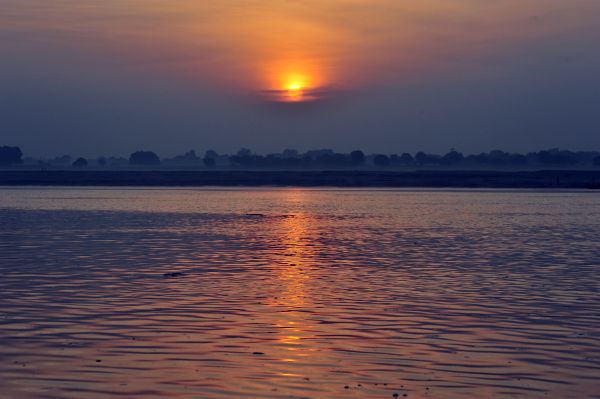New book presents an overview of the challenges facing the critically important Ganges river as a water resource for 500 million people
The Ganges River Basin spans China, Nepal, India and Bangladesh. About 1200 billion m3 of precipitation falls into the basin each year. Over 500 billion m3 flow into the Ganges river. The rest recharges the groundwater or evaporates. With a catchment area of nearly 1.1 million km2, the Ganges basin supports more than 500 million people in agriculture-based civilizations in South Asia who value the Ganges not only for irrigation, drinking water and energy production but also have a spiritual and emotional connection to the river as the Ganges is considered sacred in Hindu scriptures.

A recently published book presents the first comprehensive overview of the key issues and challenges facing the Basin region. “The Ganges is a transboundary basin primarily shared amongst Nepal, India and Bangladesh, with an estimated 4% of the catchment in China,” said Luna Bharati, the lead editor, who is a principal researcher with the International Water Management Institute (IWMI), based in the Center for Development Research (ZEF), Germany. “In this book, we have made an attempt to comprehensively cover the various aspects of the Ganges basin from a bio-physical, socio-economic and political perspective. Each chapter was jointly written by authors from the main riparian countries. The various chapters therefore also represent unique country specific views, which for certain topics such as hydropower or transboundary relations were quite diverse and sometimes contradictory. The contributing authors also represented a multitude of regional institutions so the book is also an excellent example of transboundary and trans disciplinary cooperation among regional scientists and institutions.”
The three parts of the book cover resources and uses, the environment, and governance and livelihoods. Contributions assess the status and trends of water resources, including the Himalayas, groundwater, pollution, floods, drought and climate change. They describe livelihood systems in the basin, and the social, economic, geopolitical and institutional constraints, including transboundary disputes, to achieving productive, sustainable and equitable water access. Management of the main water-use sectors and their inter-linkages are reviewed, as well as the sustainability and trade-offs in conservation of natural systems and resource development such as for hydropower or agriculture.
“Many serious challenges face the Basin, despite the billions of dollars that have been invested in the area, so this book comes at an opportune time,” said Bharat Sharma, an IWMI researcher in India. “Each chapter provides several key messages which, we hope, will facilitate future discussions on how the Basin should be developed in the decades to come.”
The annual surface water availability in the Ganges basin is high, but there is tremendous variability in the spatial and temporal distribution of water supplies. Groundwater plays a critical role in supporting the lives and livelihoods of both rural and urban populations in the Ganges Basin. The concept of the Ganges water machine, accelerating surface–subsurface water interactions to increase water availability, although not a panacea to basin problems, is probably more relevant now than in the past. Water use and variability is accelerating as the climate changes so the concept needs to be explored in detail as a solution for certain parts of the Basin. Pollution in the river and groundwater contamination, arsenic in particular, has grown into a huge issue with time, but effective systems to deal with these challenges have not been put in place.

Water policies and institutions throughout the Basin are fragmented, and have led to poor coordination for water resources planning and management. Achieving improved and integrated water management and transboundary collaboration in the Basin remains a major development challenge. Transboundary collaboration is heavily constrained by a general feeling of mistrust, lack of political vision and goodwill by the riparian countries. If this is not overcome through transparent political dialog in the nearest future, the challenges facing riparian countries related to water, hydropower and food security, will escalate dramatically.
This book is being published at a time when there is strong national and global interest in improving the health, freshwater environment and benefits from this unique river system providing sustenance to millions of poor population spread across the riparian countries. It is published at the time when countries unite globally to reach Sustainable Development Goals of 2030, and improve global, regional and national water security. “We are hopeful that this neutral, candid and science-based book will be interesting to policymakers, the private sector, the donor community and the general public who have an interest in and respect for the Ganga,” said Vladimir Smakhtin, Director of the United Nations University Institute for Water, Environment and Health.
Read the book:
Bharati, L.; Sharma, B.R.; Smakhtin, V. 2016. The Ganges River Basin: Status and challenges in water, environment and Livelihoods. Earthscan series on major river basins of the world. Routledge. 328p.

